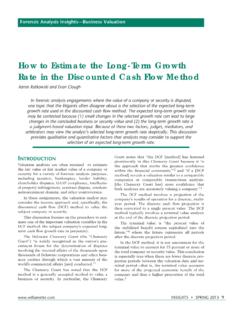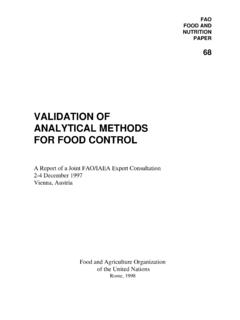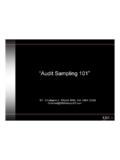Transcription of ALPHABETICAL LIST OF SELECTED GENERIC TERMS …
1 6 ALPHABETICAL LIST OF SELECTED GENERIC TERMS IN HAZARD AND RISK ASSESSMENT AND THEIR DEFINITIONS Term Description Acceptable Daily Intake Estimated maximum amount of an agent, expressed on a body mass basis, to which an individual in a (sub) population may be exposed daily over its lifetime without appreciable health risk. Related TERMS : Reference Dose, Tolerable Daily Intake Acceptable Risk This is a risk management term. The acceptability of the risk depends on scientific data, social, economic, and political factors, and on the perceived benefits arising from exposure to an agent.
2 Adverse Effect Change in the morphology, physiology, growth, development, reproduction or life span of an organism, system, or (sub) population that results in an impairment of functional capacity, an impairment of the capacity to compensate for additional stress, or an increase in susceptibility to other influences. Analysis Detailed examination of anything complex, made in order to understand its nature or to determine its essential features. Assessment Evaluation or appraisal of an analysis of facts and the inference of possible consequences concerning a particular object or process. Assessment Endpoint Qualitative/Quantitative expression of a specific factor with which a risk may be associated as determined through an appropriate risk assessment.
3 Assessment Factor Numerical adjustment used to extrapolate from experimentally determined (dose-response) relationships to estimate the agent exposure below which an adverse effect is not likely to occur. Related TERMS : Safety Factor, Uncertainty Factor. Concentration Amount of a material or agent dissolved or contained in unit quantity in a given medium or system. Concentration-Effect Relationship Relationship between the exposure, expressed in concentration, of a given organism, system or (sub) population to an agent in a specific pattern during a given time and the magnitude of a continuously-graded effect to that organism, system or (sub) population. Related TERMS : Effect Assessment, Dose-Response Relationship 7 Dose Total amount of an agent administered to, taken up or absorbed by an organism, system or (sub) population.
4 Dose-Effect Relationship Relationship between the total amount of an agent administered to, taken up or absorbed by an organism, system or (sub) population and the magnitude of a continuously-graded effect to that organism, system or (sub)population . Related TERMS : Effect Assessment, Dose-Response Relationship, Concentration-Effect Relationship. Dose-Related Effect Any effect to an organism, system or (sub) population as a result of the quantity of an agent administered to, taken up or absorbed by that organism, system or (sub) population. Dose Response Relationship between the amount of an agent administered to, taken up or absorbed by an organism, system or (sub) population and the change developed in that organism, system or (sub) population in reaction to the agent.
5 Synonymous with Dose-response relationship. Related Term: Dose-Effect Relationship, Effect Assessment, Concentration-Effect Relationship. Dose-Response Assessment Analysis of the relationship between the total amount of an agent administered to, taken up or absorbed by an organism, system or (sub)population and the changes developed in that organism, system or (sub)population in reaction to that agent, and inferences derived from such an analysis with respect to the entire population. Dose-Response Assessment is the second of four steps in risk assessment. Related TERMS : Hazard Characterisation, Dose-Effect Relationship, Effect Assessment, Dose-Response Relationship, Concentration-Effect Relationship.
6 Dose-Response Curve Graphical presentation of a dose-response relationship. Dose-Response Relationship Relationship between the amount of an agent administered to, taken up or absorbed by an organism, system or (sub) population and the change developed in that organism, system or (sub) population in reaction to the agent. Related Term: Dose-Effect Relationship, Effect Assessment, Concentration-Effect Relationship. Effect Change in the state or dynamics of an organism, system or (sub) population caused by the exposure to an agent. Effect Assessment Combination of analysis and inference of possible consequences of the exposure to a particular agent based on knowledge of the dose-effect relationship associated with that agent in a specific target organism, system or (sub) population.
7 8 Expert Judgement Opinion of an authoritative person on a particular subject. Exposure Concentration or amount of a particular agent that reaches a target organism, system or (sub) population in a specific frequency for a defined duration. Exposure Assessment Evaluation of the exposure of an organism, system or (sub) population to an agent (and its derivatives). Exposure Assessment is the third step in the process of Risk Assessment. Exposure Scenario A set of conditions or assumptions about sources, exposure pathways, amount or concentrations of agent(s)involved, and exposed organism, system or (sub) population ( numbers, characteristics, habits) used to aid in the evaluation and quantification of exposure(s) in a given situation.
8 Fate Pattern of distribution of an agent, its derivatives or metabolites in an organism, system, compartment or (sub) population of concern as a result of transport, partitioning, transformation or degradation. Guidance Value Value, such as concentration in air or water, which is derived after allocation of the reference dose among the different possible media (routes) of exposure. The aim of the guidance value is to provide quantitative information from risk assessment to the risk managers to enable them to make decisions. (See also: reference dose) Hazard Inherent property of an agent or situation having the potential to cause adverse effects when an organism, system or (sub) population is exposed to that agent.
9 Hazard Assessment A process designed to determine the possible adverse effects of an agent or situation to which an organism, system or (sub) population could be exposed. The process includes hazard identification and hazard characterization. The process focuses on the hazard in contrast to risk assessment where exposure assessment is a distinct additional step. Hazard Characterization The qualitative and, wherever possible, quantitative description of the inherent properties of an agent or situation having the potential to cause adverse effects. This should, where possible, include a dose-response assessment and its attendant uncertainties. Hazard Characterisation is the second stage in the process of Hazard Assessment, and the second step in Risk Assessment.
10 Related TERMS : Dose-Effect Relationship, Effect Assessment, Dose-Response Relationship, Concentration -Effect Relationship. 9 Hazard Identification The identification of the type and nature of adverse effects that an agent has as inherent capacity to cause in an organism, system or (sub) population. Hazard identification is the first stage in hazard assessment and the first step in the process of Risk Assessment Margin of Exposure Ratio of the no-observed-adverse-effect level (NOAEL) for the critical effect to the theoretical, predicted or estimated exposure dose or concentration. Related term: Margin of Safety Margin of Safety For some experts the Margin of Safety has the same meaning as the Margin of Exposure, while for others, the Margin of Safety means the margin between the reference dose and the actual exposure dose or concentration.
















